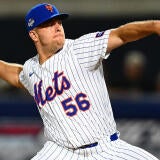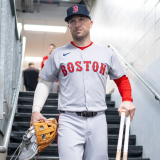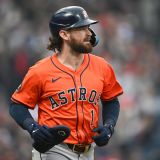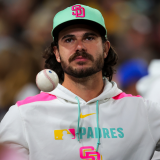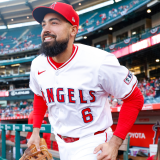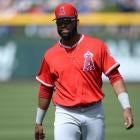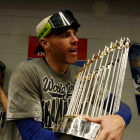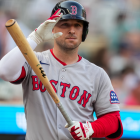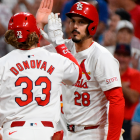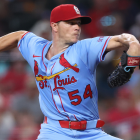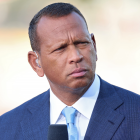
Los Angeles Angels top prospect list 2020: Jo Adell and Brandon Marsh could form dreamy outfield
The Angels have a lot of interesting outfielders and a lot of projects
With the regular season concluding, we've decided to take a look at each team's future -- not by using a crystal ball or other psychic abilities, but by evaluating their farm systems. Below you'll find our ranking of the top five prospects in the organization -- sorted by perceived future potential -- as well as five other players who fit various categories. Those categories are:
2020 contributor: A player who is likely to play a role for the big-league team next season.
Analyst's pick: A player who is a strong statistical performer and/or whose underlying measures are better than the scouting reports suggest.
Riser: A player on the way up.
Faller: A player on the way down.
One to watch: An interesting player to keep in mind (for whatever reason).
These rankings were compiled after talking with various industry sources about the systems (and players) in question. It should be acknowledged that this process is more art than science, and that there are limits to ordinal rankings. Still, it's an intuitive system, and our hope is that the write-ups will answer any questions by providing additional context and analysis of each player -- such as their pluses and minuses; the risk factors involved; and their estimated arrival date.
One last word on eligibility: We're following MLB's rookie guidelines by disqualifying any player with more than 130 big-league at-bats or 50 innings pitched.
The Los Angeles Angels have some of the most talented players in baseball on their big-league team -- those named Mike Trout and Shohei Ohtani. That hasn't been enough to get them into the postseason reliably, but they should receive some internal help over the coming year -- and could, if they play their developmental cards right, have more impact-level talent on the way.
1. Jo Adell, OF
There's a case to be made that Jo Adell is the best non-teenage prospect in baseball.
That case begins with the fact that Adell is a fantastic athlete. Here, watch him do some plyometrics then check back. Done? Good. Adell can hit the ectoplasm out of the baseball just as well as he can ghost around the basepaths or in the outfield. He might finish his development with four tools that project as plus or better -- that isn't a common profile.
Talking about only the pluses with top prospects can get boring, but there are few minuses to nitpick with Adell. The main one is that he's prone to swinging and missing. He struck out in roughly a third of his plate appearances in Triple-A over a 27-game stretch. But it's worth noting that he fanned a lot during his initial exposure to Double-A, only to return this year and hit .308/.390/.553 in 182 plate appearances -- with, it should be known, a greatly reduced K rate.
If you want a second negative about Adell it's that he's yet to appear in 100 games in a season. (He finished with 99 in 2018.) A third? Uh … he might never be on your favorite team.
Otherwise, Adell is a very good prospect. You're going to like watching him play baseball. You should get the chance to do sometime in 2020.
2. Brandon Marsh, OF
Although Brandon Marsh may lack Adell's upside, he's a high-quality prospect himself -- one who could well reach the majors in the 2020 season, perhaps alongside Adell.
Marsh missed most of June due to injury, but still appeared in 96 Double-A games this season. He hit .300/.383/.428 and delivered seven home runs and 18 steals (on 23 tries). You probably get the gist from those numbers that he can contribute across the board. He can also run, field, and throw, and he might learn to better leverage his raw power in the coming years, too.
At minimum, Marsh should develop into a most-days starter in either corner.
3. Jordyn Adams, OF
The theme for the Angels system is patience because many of their top prospects are years away from approaching the shores of the majors.
Jordyn Adams, who the Angels lured away from football in the summer of 2018, is the best of the bunch. He's one of the fastest players in organized baseball, and he could one day develop into a well-rounded player who contributes in every meaningful way. For now, Adams's job is to learn how to play baseball better. That means committing new, smoother mechanics to muscle memory and improving his pitch recognition and all those things that you can take for granted if all you ever watch is big-league ball. Mike Trout aside, ballplayers aren't built overnight.
The difference between a slow burn and a long con is perspective. Patience is either rewarded or it isn't, and when it isn't there's a tendency to feel as though someone (or something) robbed from you a precious commodity.
For the sake of Angels fans, here's hoping a few long-term projects turn into big-league fixtures.
4. Jahmai Jones, 2B
There comes a time in every prospect's career where potential has to give way to results. Though it feels like Jahmai Jones has been around forever, he isn't yet at that point.
Jones, 22, was originally selected as an outfielder by the Angels in the second round of the 2015 draft. He's since transitioned to second base, where he remains on the substandard side of things. At least he can hit, right? In theory. Jones spent this season at Double-A, and his offensive output was anything but impressive (.234/.308/.324). It's important to not read too much into those numbers, given he seemed to be working on lifting the ball more often, likely to tap into his power -- he makes up for his height (5-foot-11) with a thicker build and a quick bat. Alas, his ISO was actually lower in 2019 than in any of his prior pro seasons.
Jones' best-case scenario is turning into a decent enough defender at the keystone whose value is derived from his power, his eye, and his wheels. Will he get there? Unclear.
5. Jeremiah Jackson, INF
Another second-round infielder with the initials "J.J." and an uncertain future.
Jeremiah Jackson spent the season in the Pioneer League, where he led everyone with 23 homers but struck out in a third of his plate appearances. You don't need to be told that fanning that often against lower-level competition isn't a great sign as it pertains to his prospects.
Nonetheless, Jackson will be 19 until March and will have ample opportunity to teach his bat to find the ball more often. If he can accomplish that, he could be a well-rounded shortstop or -- should he necessitate a move down the defensive spectrum -- second baseman.
2020 contributor: Michael Hermosillo, OF
Michael Hermosillo has received a scattering of plate appearances in the Show in each of the past two seasons. He hasn't shown much in them, but there's reason to think he can become a spare outfielder. He runs well and has a good eye at the plate. The catch is that swing-and-miss prevalent in Hermosillo's game might prevent him from fulfilling his promise. It's worth noting he flattened his bat more this season as part of his load -- presumably to improve his contact rate. That fix didn't seem to work, so he'll have to go back to the drawing board this winter.
Analyst's pick: Patrick Sandoval, LHP
Acquired from the Astros in the Martin Maldonado trade, lefty Patrick Sandoval has already dipped his toes into the big-league waters. He's of interest to those who dig extreme spin rates, as well as those who like swing-and-miss changeups -- batters whiffed on half their attempts to hit his cambio. Sandoval needs to throw more strikes, and it's certainly possible he's just a reliever in a year's time, but the Angels owe it to themselves to find out for sure.
Riser: Jose Soriano, RHP
Jose Soriano, 21, spent most of this season in A-ball, where he fanned 26 percent of the batters he faced and showed off an easy delivery and promising three-pitch mix. Unfortunately, he continues to struggle with command. Time is on his side to smooth out the wrinkles, but if they prove unconquerable then he could make for a snazzy reliever.
Faller: Kevin Maitan, INF
You may recall Kevin Maitan from his days as an absurdly hyped teenager who signed with the Braves for more than $4 million in July 2016. At the time, Maitan received Miguel Cabrera comparisons. More than three years later, he spent his season in A-ball, where he hit .214/.278/.323 and struck out in nearly 31 percent of his plate appearances. He won't turn 20 until February, so get ready for another, oh, five to eight years of "remember him?" pieces.
One to watch: Will Wilson, MIF
The Angels drafted Will Wilson out of North Carolina State with the 15th pick. Wilson is the rare highly drafted collegiate hitter with far more strikeouts than walks during their time in school, and he's expected to wind up at second base. Still, there are some pluses here, beginning with a big-league-ready swing that enabled him to homer 39 times in college. He could end up as a slugging-over-on-base type -- provided he makes enough contact to make it.


